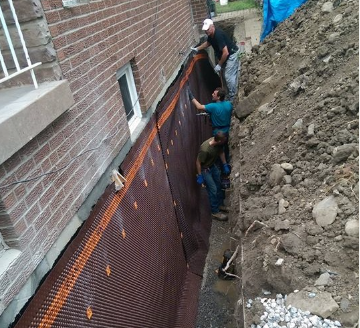Basement waterproofing is the process of making the foundation and walls of a basement impervious to water. It’s an essential step in protecting your home from water damage and moisture-related problems. In this guide, we’ll cover everything you need to know about basement waterproofing, including the different methods and materials used, signs that your basement needs waterproofing, and how to choose a waterproofing contractor.
Why is Basement Waterproofing Important?
Basement waterproofing is important for several reasons, including:
- Protecting your Home from Water Damage
Water can cause significant damage to your home, from foundation cracks and mold growth to structural damage and basement flooding. Waterproofing your basement can prevent water from seeping through the walls and floors, protecting your home from water damage.
- Improving Indoor Air Quality
Moisture in your basement can lead to mold growth, which can negatively impact indoor air quality and lead to health problems, such as respiratory issues and allergies. Waterproofing your basement can help prevent moisture buildup and reduce the risk of mold growth.
- Increasing the Value of Your Home
A Basement Waterproofing can add value to your home by protecting it from water damage and improving indoor air quality. This can be especially important if you plan to sell your home in the future.
Signs that Your Basement Needs Waterproofing
There are several signs that your basement may need waterproofing, including:
- Damp or Musty Odors
If you notice a damp or musty odor in your basement, it could be a sign of moisture buildup. This can lead to mold growth, which can negatively impact indoor air quality and cause health problems.
- Water Stains or Damage
Water stains or damage on the walls or floors of your basement are a clear sign that water is seeping through the foundation. This can lead to structural damage and basement flooding if left untreated.
- Cracks in the Foundation
Cracks in the foundation walls or floors can allow water to seep through and cause damage to your home. If you notice cracks in your foundation, it’s important to have them inspected by a professional.
- Efflorescence
Efflorescence is a white, powdery substance that forms on basement walls and floors due to moisture buildup. It’s a sign that water is seeping through the foundation and can lead to structural damage if left untreated.
Methods of Basement Waterproofing
There are several methods of basement waterproofing, including:
- Exterior Waterproofing
Exterior waterproofing involves excavating the soil around your home’s foundation and applying a waterproof coating or membrane to the exterior of the foundation walls. This method is effective at preventing water from seeping through the walls, but it’s also the most expensive and invasive.
- Interior Waterproofing
Interior waterproofing involves installing a drainage system and sump pump inside the basement to collect and pump out water that seeps through the walls or floors. This method is less invasive and less expensive than exterior waterproofing, but it’s not as effective at preventing water from seeping through the walls.
- Crystalline Waterproofing
Crystalline waterproofing involves applying a crystalline waterproofing agent to the surface of the foundation walls or floors. The agent penetrates the concrete and forms crystals that fill in the pores and capillaries, making the concrete more impervious to water. This method is effective at preventing water from seeping through the walls or floors, but it’s not as effective at controlling hydrostatic pressure.
- Injection Waterproofing
Injection waterproofing involves injecting a waterproofing material, such as epoxy or polyurethane, into cracks or voids in the foundation walls or floors. This method is effective at stopping leaks and preventing water.
